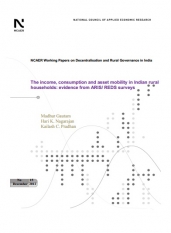The income, consumption and asset mobility in Indian rural households: evidence from ARIS/ REDS surveys
Kailash Chander Pradhan
Hari K. Nagarajan
Madhur Gautam
December 2012
The study examine the mobility of households with respect to time-independence, positional movement, and directional income, consumption and assets movement using transition matrices. Transition matrices are most intuitive tools to comprehend mobility and are based on Shorrock’s (1978) measures of mobility. Economic mobility is a significant consequence of income inequality and growth. In this paper, the study have used a unique ARIS/ REDS surveys 1999 and 2007 data set for rural India to determine the reasons and magnitude of income, consumption and income mobility. The economic mobility has estimated for the land classes, ICRISAT agro-climate zones, different region such as east, south west and north, consumption classes, income quintiles, agricultural profit classes, assets classes, caste groups and gender groups. There exists wide income, consumption and asset diversity among different classes.
National Growth and Macroeconomic Centre
Agriculture and Rural Development







